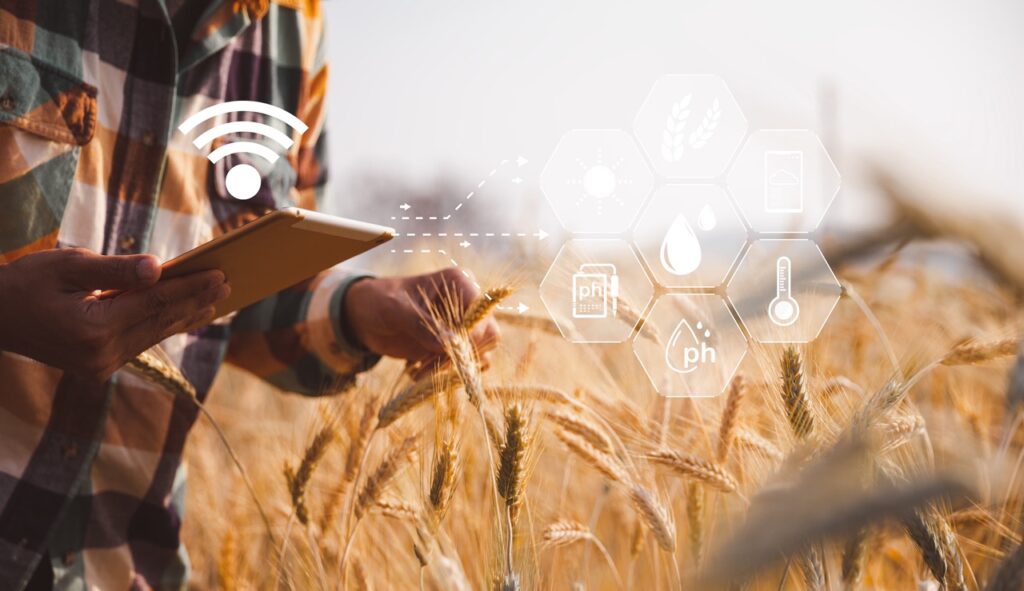Agtech makes agriculture smarter, and that’s a win for farmers, our planet, and people.
Farming and agriculture have always relied on technology and innovation to improve resource allocation and increase yields.
For example, handheld tools were the norm until the cotton gin’s introduction in 1793, and chemical fertilizers, grain elevators, and the gas-powered tractor revolutionized farming and agriculture in the 1800s. In the 1990s, farmers started using satellite imagery to plan their work.
 Today farmers have begun to embrace the IIoT (Industrial Internet of Things) – arguably the most significant agricultural innovation of the last decade. Smart agriculture is now common among farmers, and precision agriculture is becoming the norm, thanks to sensors and automation.
Today farmers have begun to embrace the IIoT (Industrial Internet of Things) – arguably the most significant agricultural innovation of the last decade. Smart agriculture is now common among farmers, and precision agriculture is becoming the norm, thanks to sensors and automation.
Still, there are many miles to go before agtech can more broadly address global food insecurity and combat our climate and sustainability challenges; we will get there.
“The key to sustainable agricultural growth is a more efficient use of land, labor, and other inputs through technological progress, social innovation, and new business models. For agriculture and aquaculture to respond to future challenges, innovation will need to improve the efficiency with which inputs are turned into outputs and conserve scarce natural resources and reduce waste.” —The Future of Food and Agriculture: Trends and Challenges, Food and Agriculture Organization of the United Nations
Keep reading to learn how agtech helps farmers improve processes and save money, while also meeting the food needs of a growing global population.
Precision Farming and Smart Agriculture
Many farmers have already adopted high-tech farming technologies and techniques to improve day-to-day efficiency and increase profits. Field sensors allow farmers to gather detailed topographic and resource maps and helps them carefully measure and monitor soil acidity and temperatures. Precision farming and smart agriculture technologies also help farmers predict upcoming weather patterns.
Farmers who embrace agtech can monitor equipment, livestock, and crops from mobile devices, and gather real-time produce and livestock feeding data. Technology, like ours, even helps farmers access information to forecast future yield and livestock needs.
Sensors and monitoring tools give farmers far-reaching information to drive field management decision-making that enables better resource allocation, increases yields and saves money. For example, real-time data can help farmers identify areas that need more water or fertilizer or find places where crops receive too much water or fertilizer.

More agtech use-cases:
Automated Irrigation and Compliance
Agtech enables farmers to schedule irrigation at off-peak hours and save up to $30,000 per year in energy costs. And with agtech, farmers can automate water consumption reporting processes to ensure regulatory compliance.
Grain Bin Level Monitoring and Control
Precision farming technologies give farmers real-time visibility into storage conditions and use automation to ensure blowers only operate during off-peak electrical hours, saving up to 50% in overall energy costs.
Herd Health Tracking
Agtech helps farmers monitor feed intake to deliver accurate rations to improve livestock health and mitigate feed shrink.
Self-Driving and Autonomous Tractors
Real-time kinetics (RTK) in precision agriculture improves steering and guidance accuracy up to 100x compared to traditional GPS.
Smart Weed Control
IIoT powers high-accuracy robotic weeders to reduce herbicide consumption by as much as 20%.
Using agtech to address food insecurity.
By addressing factors like soil health and food waste, agtech can help ensure food is grown as sustainably and efficiently as possible and maximize each bite’s caloric benefit.
Agtech revolutionizes virtually every step of the process.
And it’s about more than ensuring a bountiful harvest and limiting food waste; it’s also about connecting rural farmers and the world-at-large, uncovering new food distribution channels in remote areas, and introducing alternative cultivation methods in rugged and unforgiving environments.
Technology and innovation are a deciding factor in eliminating global hunger. Precision agriculture helps farmers become more efficient, profitable, safer, and environmentally friendly.
“Farms and agricultural operations will have to be run very differently, primarily due to advancements in technology such as sensors, devices, machines, and information technology. Future agriculture will use sophisticated technologies such as robots, temperature and moisture sensors, aerial images, and GPS technology. These advanced devices and precision agriculture and robotic systems will allow farms to be more profitable, efficient, safe, and environmentally friendly.” —Agriculture 4.0: The Future of Farming Technology, World Government Summit
As agtech adoption expands and farms become more connected, productivity and efficiency will increase in the coming years. We anticipate that millions of agriculture-specific IIoT devices will be in action by the end of 2020. And in the coming decades, the average farm will generate more actionable data than anything imaginable today.
Other industries are fearful of technology that replaces humans with sensors and robots, but farmers, always in need of more human power and resources, dream of technologies that increase yields and save money with less time and effort.
Is your farm Smart? Find out today – get in touch for complimentary FreeWave Smart farm assessment.



